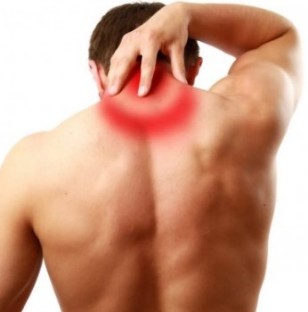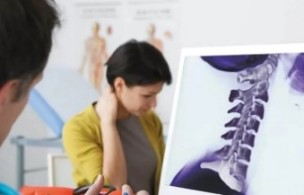Osteocondrose it is a disease of the spinal cord, which is characterized by the development of changes in cartilage, intervertebral discs, and reaction processes in the tissues.
The neck osteocondrose of the spine is different in its manifestation from the dorsal, and the lumbar spine from degenerative disc disease. The symptoms of degenerative cervical disc disease-related anatomical features of the cervical spine. Dimensions of vertebrae, the cervical and the smaller the size of the other departments. The neck department, you constantly try to load, keeping your head, and when I do, it's different for maximum freedom of movement.

The causes of degenerative disc disease
The reasons for the development of the disease in the first place, due to age (the aging of the body, and the development of a destruction of the bone tissue and the cartilage. Also, we can mention the following reasons for the occurrence of degenerative disease in the us.
- violation of posture,the
- the reduction in the motor activity training as a result of a sedentary life-style,
- being overweight is the result of metabolic disorders, it is putting a strain on the discs of the spinal column
- a hereditary factor
- in the long term, and the physical load,
- anomalies of the vertebral column.
Consistent physical activity, proper nutrition, and healthier, and visibly reduces the likelihood of the development of the disease, and it can also reduce the impact on the overall well-being.
The symptoms of degenerative disc disease of cervical spine
The symptoms of degenerative cervical disc disease, are different symptoms in the other departments of the spinal cord. This is due to the fact that the cervical vertebrae have a different structure, and they are very close. Thus, any displacement is a sharp pain in his head. In addition, in the region of the cervical department of the spine, often zaselyalsya nerve head and the arteries.
The neck osteocondrose of the vertebral column is shown if any of the following symptoms:
- The feeling of pain, the pain can be felt in different parts of the body. This is due to the fact that it happens is a pinched nerve endings and muscle portion of the body corresponding to it.
- The weakness in the upper extremities, is seen to be due to the crushing of the nerve endings that are responsible for physical activity.
- The Total of the turns of the head, and the emergence of a crisis of a vertebra of the cervical region of the departments – they occur due to changes in the structure of the intervertebral disc, the occurrence of formations in the bone.
- The low sensitivity of the hands.
- The weakness and dizziness will appear, because of the entrapment of the artery in which provides blood flow and nutrition to the brain.
- The loss of hearing and vision to get into the last stage of the disease, when it is in breach of the circulation of the blood to the cerebrum.
Signs of degenerative cervical disc disease
- A Radicular syndrome is characterized by a pinched in the split of the beam in the region of the neck. It manifests itself in a sharp pain that can be felt in the shoulders, and a blade.
- Of the spine syndrome, manifested a strong pain in the head, pain in the temples and the nape of the neck.
- As a reflection of a syndrome that is characterized by pain in the cervical area, the department, which may increase when you use any of the movement of the head. The pain may move up into the shoulder and chest.
- The cardinal's syndrome – is similar to an attack of angina pectoris, to determine that it is an extremely difficult one.
The degree to which the development of the disease, degenerative disc disease of the lumbar disc of the vertebral column
To the extent of its development, the disease goes through several stages. Each stage has its own characteristics and it is characterised by certain signs.
- 1 is a phase. Bone or cartilage, soft bone, it gradually begins to break down. The symptoms of the disease are not visible. And, more often than not, the patients are in their you simply don't notice and call in to the fatigue and pain, excess of work and stress.
- The 2-stage. The height of the disc begins to shrink, they will appear as cracks. The patient experiences constant pain, weakness, numbness, and facial.
- 3 on the stage. They begin to form a herniated disc, the damaged cervical vessels, and muscle. They appear with complaints of shortness of breath, pain in the region of the nape of the neck.
- 4 is a phase. The bone that protects the bone in excess of the load started to increase, resulting in a zaselyalsya nerve endings. Occurs, the rigidity in movement, damaged joints and surrounding areas.
This is the danger of degenerative cervical disc disease
In the region of the cervical department of the many nerves and arteries that supply the nutrition unit in the brain. In the event of a breach of your work, your brain will not have enough energy for normal functioning. This is a situation that may compromise the physical activity of a person, which would cause pain in your limbs, as well as the loss of co-ordination.
In the implementation stage of the degenerative disc disease can develop thrombosis, stroke, and other diseases, which are dangerous to human life.
So, when asked, are any of the symptoms associated with this disease, it is recommended that you consult your doctor.
The diagnosis of the cervical spine
For a survey of the diseases of the spinal column, are used in the following types of diagnostics:
- the x-ray is an ineffective way of diagnosing the disease,and
- MRI (magnetic resonance imaging)that shows the bone structure, which is formed from the herniation of the disk, and their size,
- A CT (computed tomography) scan be ineffective in comparison with that of magnetic resonance imaging, as well as the use of this method of diagnosis, it is difficult to determine the size of the hernia,
- Ultrasound duplex scan is used and when it broke to the general blood circulation. This research has shown that the velocity of the blood flow, and the presence of obstacles in its path.
In the treatment of degenerative disc disease of cervical spine

In the treatment of degenerative cervical disc disease in the spine must be carried out in the complex, depending on the situation. A positive effect can also be achieved through the integrated management approach to the individual, and that includes medical treatment, physical therapy, procedure, healing of the physical education and massage, can also be used with the tools of folk medicine.
In the period of aggravation of the treatment of degenerative cervical disc disease in the spine to improve circulation, elimination of muscle spasms. In this case, we are given the means with which to improve blood flow and circulation, anti-inflammatory and pain medication vitamin complex.
Therapeutic exercise, when osteocondrose neck
Of medical gymnastics as it gives visible results and is less dangerous than during the recovery phase. The principle of the action of the repair of physical education is to restore the blood flow to the damaged parts of the body. Exercises in physical education doctor, the patient should not feel pain or discomfort.
Exercises for the cervical spine is to strengthen the muscles of the neck, and it also serves the role of preventing the development of degenerative cervical disc disease.
Massage osteocondrose of the cervical spine
The massage is carried out with the aim to strengthen the muscles and relieve the pain. Depending on the stage of development of the disease, there are different techniques of massage. Classic massage techniques are:
- again – this is the impact on the superficial layers of the skin. It begins with a foot massage, neck area, and continues to the collar bone and under your arms.
- squeeze – in this case, the impact for the type of massage that occurs in the deeper layers of the skin. The width of the neck with the thumb and the index finger performs the movement from the perception of the skin that seem to be pushing.
- the rubbing is performed for the purpose of heating, and the relaxation of the skin to improve the blood circulation in the neck area of the spine.
- knead the dough – it has special restrictions, as well as a profound effect on the underlying tissue. If you don't do this to reception as it can harm the patient.
In cases where the patient has a sensation of pain that occurs on only one side of the massage, you must begin to comply with up with a healthy portion of the neck, gradually moving to the part of the cervix, where it appears to the eye.
The massage can be done at home and in a health care facility. However, while it is running, you should be very careful in order to avoid the worsening of the disease or not, makes it worse.
The prevention of the occurrence of degenerative cervical disc disease
To prevent the emergence and the development of the disease, it is recommended to adhere to the simple rules:
- leading a healthy lifestyle, carry out exercise regularly in the pool;
- to diversify your diet from the food products that are rich in magnesium, and calcium;
- in the case of those who work as several times a day in order to do this year.
- to sleep, you should choose a mattress with a pillow-top mattress and a comfortable pillow.
















